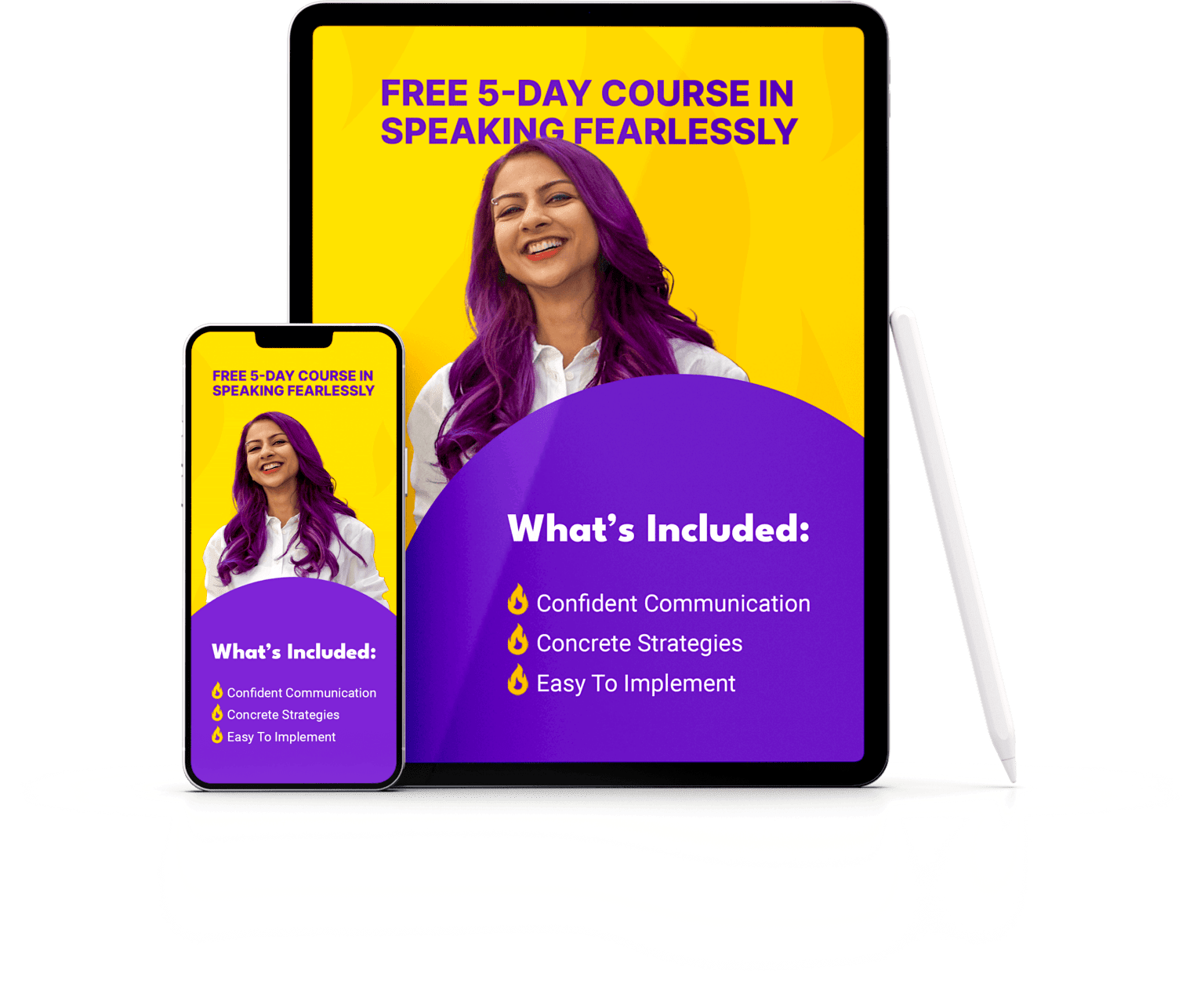Many years ago I found myself standing before a room full of attentive faces in Shenzhen, China.
Eager to share my tips on a topic close to my heart – “Storytelling in Public Speaking” – I had prepared a mix of stories, anecdotes and examples. I was super excited to share everything I knew with my new audience.
I began with a simple question, aiming to spark engagement: “Has anyone seen an interesting ad recently?” I expected to see a bunch of hands go up.
Instead, all I heard was… crickets.
Surprised, I salvaged the situation with some humor: “No one’s seen an interesting ad? Wow, you’re a tough crowd!” I got a few polite chuckles, and after what seemed like an eternity, a couple of hands went up in the air.
That experience taught me an invaluable lesson in addressing multicultural audiences.
I’ll share with you exactly what my biggest lesson from this experience was in this article – along with a complete framework for adapting your presentation for multicultural audiences. Let’s make sure you ace your talk or presentation every time you’re speaking to audiences that are culturally different from you.

Credit: Photo by peoplecreations on Freepik
What’s inside:
1. Understand your multicultural audience’s expectations
I realized what had gone wrong that night I presented in China.
I’d missed a cultural nuance.
My audience wasn’t used to interacting openly on a public platform. If you asked them a question from the stage they’d feel like you put them on the spot! I would have known this if I had learned more about what they were expecting from our interaction.
How to adapt to audience expectations
Perhaps you’re delivering a presentation, webinar, training, making a pitch or talking on a podcast to a multicultural audience. They come with different beliefs and values – and even different worldviews.
The basic rule of public speaking is more applicable than ever when you’re speaking to a multicultural audience: know your audience as closely as you can. Understand what they expect from presentations – what kind of vibe and tone do other presenters set? What does the audience need and want to achieve? How do they react and interact?
For example, if you know that your audience is not expecting super high energy in presentations, then you don’t want to walk in like a motivational speaker, aiming to get them riled up. That approach may alienate them.
How to disrupt expectations
However, once you understand what the audience expects – feel free to disrupt! It’s a fine line between accepting what’s expected of you and breaking away from expectations gently so that the audience goes with you where you want to lead them.
Let’s take the same example as earlier: if you want to bring high energy to an audience that’s expecting a one-way lecture – explain this to them. Let them know that you’ll be doing something different from what they’re used to. And then ensure that you’re keeping a close eye on exactly how they react so you can make changes to your tone and energy on the fly.
It absolutely helps to know how your audience may behave in emotional or confrontational situations. Different cultures have different degrees of emotional expressiveness.

Credit: Photo by HBR
Imagine that you’re addressing a client’s team from the Philippines. Now you know they might be emotionally expressive and responsive. This means that if you use an emotional anecdote, you might see them respond to it visually vs an audience from Japan. This doesn’t mean you can’t include emotions when speaking to an audience that may not be as emotionally expressive. But it can help manage your own expectations as the speaker so that you don’t feel discouraged at the lack of audience response.
2. Read the room

Credit: Photo from Giphy
Once you step into that room or Zoom call – it’s vital to read how people are reacting to you as a speaker. It’s a crucial skill to develop so you can quickly pick up the audience’s energy and vibe.
Reading the room in person
When you’re presenting in person, you can pause and observe the audience throughout your talk. Read the visual cues to know how your audience is reacting.
You can observe these:
- Facial expressions: are they smiling or giving you confused looks?
- Body language: are they leaning forward and showing interest or slumping in their seats?
- Eye contact: are they maintaining eye contact with you or looking at their phones?
Based on what vibe you read, you may want to adapt quickly. Ask a simple question if they look disengaged, for instance. Offer to slow down or repeat something if you see a lot of confusion on their faces.
Be open to a few spontaneous questions or comments. They give you valuable insights into how you’re performing and if the audience is with you and enjoying it.

Image by mego-studio on Freepik
Reading the room in an online presentation
During online presentations and webinars, you may not get to see your audience. In this case, you can “read the room” by engaging them throughout the talk and gauging their response.
I’d recommend a few ways of doing this:
- Asking questions about them, such as, where they’re joining from and what’s their level of experience with the topic. You can also ask simple Yes/No questions right at the start to warm them up.
- Welcoming them by calling their names.
- Running a poll to give them a chance to interact with you.
- Inviting an example after you’ve explained a concept or made a point.
- Pausing at the end of each section and asking if they’ve got any quick questions (and pushing any time-consuming ones to the Q&A section).
The idea here is to get regular feedback from your audience even if you can’t see them so you feel more confident and in control while delivering your talk.
3. Adapt your presentation content
When faced with the prospect of presenting to a multicultural audience, you might find yourself in one of two situations:
- You’re presenting to a group of people who are coming from a diverse multicultural and geographical background (like at a webinar). This means that the entire room may not be likely to share jargon, cultural or local references or even the same sense of humor.
- You’re presenting to a homogenous group (like me when I was presenting in China) but one that is culturally different from you. This means that the entire room might get certain local references or types of humor but they might be different from the ones you’re familiar with.
In both situations, it would serve you well to adapt your content so that it’s not just easily understood but also instantly relatable.
How to use cultural references

Credit: Photo by Giphy
One of the best ways to connect with your audience instantly is to include cultural references. However, the type of cultural reference depends on whether you’re addressing a culturally homogeneous or diverse group.
If you’re talking to a culturally diverse audience, stick to universally recognized cultural references, like the TV show Friends or Beyoncé.
If you’re addressing an audience that belongs to a specific country, company or group, you could incorporate references that are known to them. For instance, instead of saying “That’s like finding a needle in a haystack”, use what’s popular in their culture. For a Japanese audience, it might be “a single drop in a vast ocean” or “finding a grain of rice among chaff”.
On the flip side, check your presentation content for anything that might not be instantly recognizable to your audience and change it. You’ll often find that changing references like this won’t affect the point you’re making – but it’ll make it more easily understandable by the audience. It helps to ensure that your cultural references are resonating well by avoiding or changing out:
- Obscure TV shows or celebrity references that may not be well known.
- References that only one segment of the audience understands (excluding the rest).
- Making offensive or outdated references.
How to use humor with culturally diverse audiences
I like to take inspiration from the best here: stand-up comedians on tour.

Credit: Photo by Giphy
If you’re a stand-up comedian on tour, one day you’re performing in Toronto and next week in Houston. And a month later in Paris and then London. You use the same comedy set but need to be able to make it relevant to diverse audiences.
A trick that stand-up comedians use is to adapt their intro so that it connects with local audiences instantly. You can use this strategy too.
Let’s say you’re presenting to a group of people at a company. Find something they can all relate to: an insider joke, a recent award they won or a funny incident that everyone’s able to laugh at.
A bonus tip: add the local references right at the beginning of your presentation or talk.
Here’s why it matters.
The beginning of your presentation is a crucial time for you to engage your audience. Adding something specific to them will help them relate to you. It’ll make them feel that you’ve taken the time to know them.
They’ll laugh with you and immediately see you as an insider. That feeling of relatability is priceless. They’ll see you as a trustworthy and reliable person and are more likely to listen attentively.

Photo by ThisisEngineering RAEng on Unsplash
However, humor has many nuances, which makes it easy to go wrong with. What’s considered as humor in one culture may be offensive in another. This makes it especially tricky to use with an audience that’s diverse.
In countries like the US and Canada, people usually appreciate (even expect) direct humor. However, the same flavor of humor may not be preferred in countries like Japan and China. Instead, they appreciate subtle, indirect humor based on wordplay.
How to use sports idioms
Popular sports idioms are a great way to make your point. You just have to make sure that the sport is relevant to your audience.

Credit: Photo by Giphy
Let’s say you’re planning on using “Hit it out of the park”. But if your audience isn’t familiar with baseball, you can either choose to make it more general so that it’s understood regardless of what sport people might be familiar with or more culturally specific.
For example, use “Hit it for a six!” in countries where cricket is played such as Australia, the UK, New Zealand, South Asia, Southern Africa and the West Indies.
What if your audience is a mix of multiple cultures (or not be as interested in sports)?
Your best bet then is to avoid sports idioms and use alternative phrases like “nailed it”, “crushed it”, “aced it” or “smashed it”.
How to use expressions and proverbs
There might be expressions and idioms that you use without thinking, but they may either not be understood or be sensitive for your audience.

Credit: Photo by Giphy
For instance, it’s common to use the expression “my two cents” in the US. But it may not make much sense for people who don’t use cents as part of their currency. Instead, I’d use a simpler expression like “here’s my take on that” or “here’s my point of view”.
Do a sense check on your presentation to see if you’re using idioms or culturally specific expressions and whether a culturally diverse audience would easily understand them.
If you’re presenting to a homogenous audience, you can even be bold here by first sharing the idiom as you know it and then using a locally appropriate one to emphasize its meaning and significance.
Interesting note: classic proverbs are usually understood the same way across cultures.
- “Action speaks louder than words”
- “Every cloud has a silver lining”
- “Look before you leap”

Credit: Photo by Giphy
How to adapt stories
Storytelling is powerful when you use it in your presentation. But all stories aren’t equal.
Did you know that Western storytelling often focuses on individual heroes, while Asian cultures may focus on community-driven narratives? If you’ve watched Jackie Chan or Bruce Lee movies, you know what I’m talking about.

Credit: Photo by Giphy
I recommend including stories with universal themes like resilience, hope and chasing dreams. That way, even if you’re talking about characters that the audience may not be familiar with, they will be able to relate to the theme and emotions.
If you’re considering humor or tragedy, it helps to study the cultural nuances around these themes. It’s also generally “safer” to stay away from graphic details around death or tragedy so that you don’t turn the audience off with too much gore!
4. Adapt your gestures and body language
Regardless of the type of audience you’re addressing, confident body language is universal. You can’t go wrong with good posture, smiling and making eye contact (but not excessively in some cultures!) You can also use a range of gestures when you speak – some of these are understood well across cultures and interest groups.
Here are some gestures that you can use that help illustrate your content effectively when speaking to a multicultural audience:
- “Painting with your hands”: draw a visual representation of the concept in the air with your hands and help your audience understand your message better.
- Counting: whenever speaking about figures, use your hands to count them off. This also helps the audience keep track of what you’ve said.
- Open palms: This is a gesture that shows trust and transparency – like you have nothing to hide.

That’s me showing you an open palm. Do I look trustworthy?
An interesting note here is to consider gestures that may be misunderstood by your audience.
For example, it’s common in many cultures to show a V sign indicating “victory” or “peace” – whether the palm is facing inward or outward. However, the V sign with the palm facing inward is considered an insult in the UK and South Africa.
Did you know that “thumbs up” – a common gesture for approval – is considered rude in some Middle Eastern cultures? If that’s your audience, you may have to try a gentle nod, a smile, or both to convey the same meaning.
It pays to know which gestures translate well somewhat universally and which ones could be misunderstood.

Credit: Photo by EnglishLive
5. How to use your voice for a multicultural audience
The volume of your voice, the pace, pitch, inflection and energy – each one of these needs special attention to make your talk impactful and relevant for your audience.
Consider some of these universal aspects of your tone for an impactful delivery:
- Pace: Intentionally vary your pace when you speak instead of being monotonous. Aim to speak with a bit more energy when building up tension in your story, or slow down when making an important point.
- Pitch: You can use a higher pitch to show excitement, or a lower one to build drama.
- Enunciation: By speaking clearly and stressing important words you make it much easier for the audience to understand your message.
- Pause: Pausing has a dramatic effect when used at the right time. When you’ve said something complex, taking a pause gives your audience time to understand it and feel the impact. Pausing just before saying something important will build suspense by making them think “What will they say next?”
Something to consider: Your accent or your pace of speaking may be difficult to understand for an audience who are not native speakers of your language. You don’t have to change your accent- just speak slowly enough for them to understand.
How to adapt your tones to match your audience

Credit: Photo by Giphy
If you’re speaking to a specific culture, aim to find out more about their expected tonal norms. For example, in African American, Caribbean and Latino cultures, loud and expressive speech might be more acceptable than in some Alaskan native and Latin American indigenous cultures, where they expect softer tones.
Remember my story of presenting to a Chinese audience?
During that presentation, I assumed that asking them a question would get me some responses. But they didn’t want to be “put on the spot” that way, and no one answered.
So what did I do? At the time, I cracked a joke about it being a tough crowd. But in later talks, I wanted to challenge the audience’s expectations.
So I pointed to the benefits of asking questions and getting personalized responses. I lowered my own expectations about getting answers and mentally prepared myself to pause a bit longer for them to respond. And it worked! I got more and more responses each time I prepared the audience for the interactive nature of the presentation ahead of time.
How to adapt formal and informal tones in your talk
A mistake that I’ve often seen presenters make is to err on the side of being too formal. Yes, some presentations are more formal than others- but that doesn’t mean you need to sound like an encyclopedia or an academic journal.
Consider replacing stuffy formal phrases like “The data suggests a significant correlation…” with “So, what we’re seeing here…”.
Even senior management, experienced investors and company presidents will appreciate you keeping things simple and easily understandable.
Conclusion

Credit: Photo by Freepik
My rule of thumb when it comes to addressing multicultural audiences: say what you mean, and mean what you say.
It’s tricky to adapt to an audience that might be culturally different from you. But if you take time to understand them and ensure that your content is accessible to them regardless of the culture they’re from, you’ll always speak with impact.
When it comes to adapting your content and delivery, I do want to leave you with this thought: Just because a certain behavior or mannerism isn’t “expected” by your audience – that doesn’t mean you can’t use it. Understand the implications of using it – will it help make your presentation more impactful? Are you in a position to challenge the norms? And then go for it. There’s a fine line between accepting different cultural norms and completely assimilating versus gently challenging the norms when it serves your talk (and doesn’t alienate the audience).
I hope you’ve found the strategies and tips I’ve shared in this blog post helpful.
Need help with your upcoming talk or presentation for an international audience? Reach me here.



